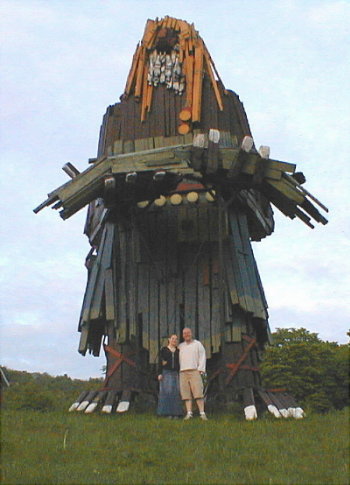Global Tales from Two Young
Travelers
Småland in a day
By
Emily Reisch and Jon Minor
Our roommate Harry had promised to borrow a car
and take us around some day. When Sweden’s cold spring finally
became warm, he took us all around Småland.
Småland, the area that Jönköping
is located in, is similar to a province. As we drove, Harry explained
some things about the area.
Along most of Sweden’s highways are tall, woven wire fences. Harry
told us that it prevents many accidents because it stops deer and moose
from running across the road.
We paid 9.2 kroner per liter to fill the car with gas. We were surprised
when we calculated that it was $4.56 per gallon.
Our first stop was Öland. Öland is a very small and narrow
island off the east coast. It’s known for 400 old wooden windmills.
It’s connected to the mainland by a six kilometer bridge.
Öland is also the summer residence of the Royal Family. We walked
through the fragrant palace gardens. There were paths through forest
along with perfectly manicured grass and rows of bushes trimmed into
squares and globes.
Next was the castle in Kalmar. It was a very sunny day and Swedes were
out soaking up every ray along the moat, wherever there was a free patch
of grass. We walked along the top of the rampart walls and looked out
over the harbor.
Glasriket is an area in Småland where 17 glass factories are scattered
through the forest. In the 16th century, King Gustav Vasa’s courtiers
concluded feasts by smashing as many expensive Venetian glasses as possible.
The king imported Venetian glass blowers to his court, thinking it would
be cheaper for them to break home-blown glasses than imported ones.
Because we were traveling on Ascension Day, many shops had holiday hours
and the glass blowers weren’t working. We were disappointed that
we didn’t get to watch blowing, but we found several pieces to
take home from the second shop. Pieces with slight flaws, usually tiny
air bubbles, are sold at discounted prices.
The crystal added a lot of weight to our suitcases, but Swedish crystal
and design is known all over the world. A slight tap of a fingernail
sets the glass ringing with a very high, clear pitch. Harry also purchased
a going-away present for us. It was a large plate with a traditional
hand-painted flower. He told us that many people in Sweden owned things
with this design.
We visited a church in Växjö that had a glass alter. The artist
has perfected techniques for smelting large pieces of glass.
Växjö also has an emigrant museum. Many Americans looking
for their Swedish roots visit every year. The majority of the 1.4 million
Swedish immigrants to America came from Småland.
As we relaxed and ate kebabs for supper, we thought what a fun, busy
day it had been. Harry, who’s lived around Jönköping
his entire life, kept thinking of more things to show us on the way
home though.
In Tennhult, which is about 20 kilometers from Jönköping,
we stopped at Riddersberg. The artist Calle Örnemark used to live
there, and he created many large sculptures out of wood behind his house.
Sadly, he moved away and his “gallery” now is not maintained
and overgrown with weeds.
Örnemark created a welcoming figure on the motorway near Jönköping.
Harry took a photo of us standing under the huge figure of Vis. He holds
a piece of turf as if he’s about to hurdle it into Lake Vättern.
Legend says that Vis and his wife, who are giants, were walking home
from a party one evening and his wife couldn’t step over the lake.
He picked up a piece of ground and threw it into the lake so she wouldn’t
get her feet wet. The earth he threw became the island of Visingsö.
Our last stop was the highest hill in Huskvarna, home of the Husqvarna
motorcycle and chainsaw, which is next to Jönköping. We watched
the sinking sun turn the sky pink over the city and the lake and realized
how much we were going to miss Sweden.